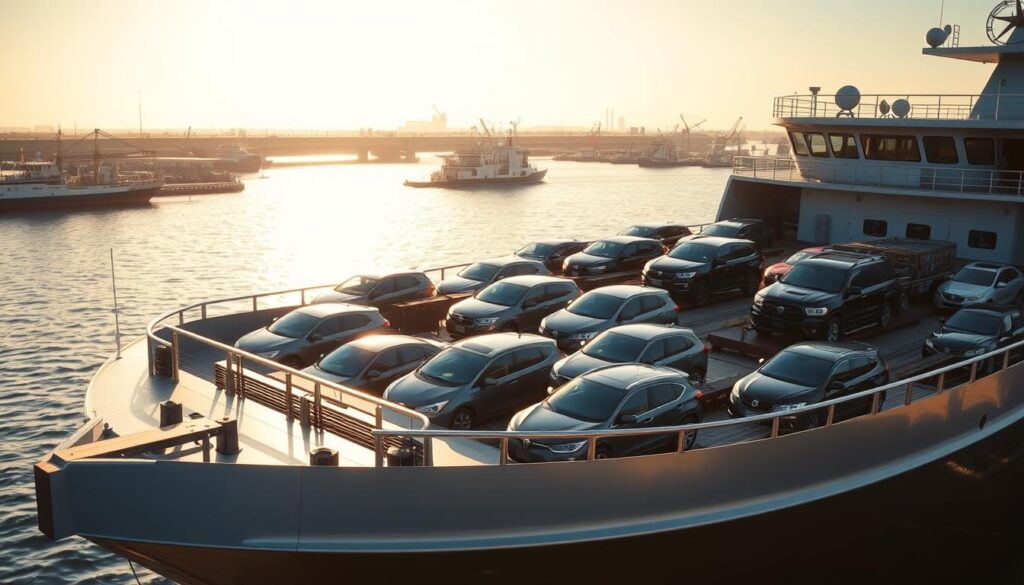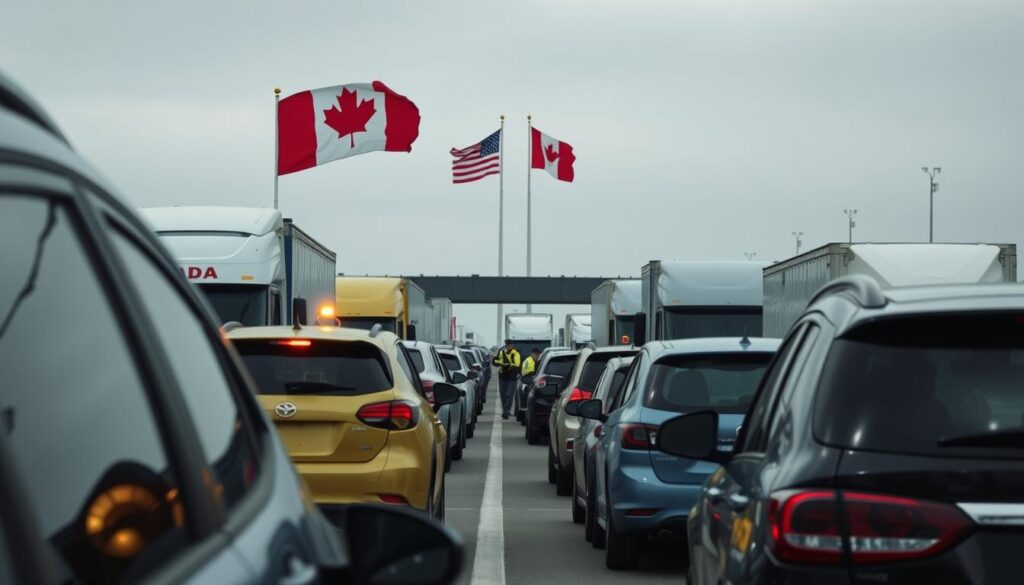Curious how much it really takes to move a vehicle across the border—and what adds up on the final bill?
BestCarShippingInc guides owners through each fee layer. This Buyer’s Guide breaks down taxes, RIV checks, inspection needs, and transport choices. It shows typical ranges for enclosed, open, and driveaway options so owners can plan a precise budget.
The firm explains how seasonality, route availability, and vehicle specs change final numbers. Most vehicles cross smoothly when forms are correct and an experienced company coordinates with carriers and CBSA.
Call for a clear quote and personal help: (307) 288-5972 or info@bestcarshippinginc.com. Expect transparent pricing, vetted carriers, documented handoffs, and proactive updates during the move.
Key Takeaways
- The guide breaks down every cost layer so owners can budget accurately.
- Taxes, RIV rules, and inspections directly affect timing and final prices.
- Transport method and seasonality change rates and delivery times.
- A professional company reduces delay risks with verified carriers and insurance.
- Request a written quote to lock rates and timelines: (307) 288-5972 or info@bestcarshippinginc.com.
What does it cost to ship a car from the US to Canada right now?

Current market totals for moving a vehicle across the border commonly range from $3,500 to $7,000. That all-in figure covers transport, taxes, RIV fees, inspections, and any necessary modifications.
Quick answer for today’s market: typical totals and key drivers
Major drivers are transport method, taxes at the border based on vehicle value, provincial sales tax, and safety modifications. Open truck runs about $800–$1,000; enclosed about $1,200–$1,400; driveaway $1,000–$1,800. Inspections add $100–$250 and modifications often start near $200.
| Component | Typical Range | Notes |
|---|---|---|
| Transport method | $800–$1,800 | Open, enclosed, or driveaway; distance affects rates |
| Inspections & mods | $100–$500+ | Safety upgrades, metric conversions |
| Taxes & fees | 5% GST + provincial | RIV fee and possible duty on non-USMCA vehicles |
Who this Buyer’s Guide is for and how to use it
This guide helps owners, dealers, and fleet managers estimate true totals and choose a method that matches risk and timing. Start with Section 3 for taxes, Section 4 for RIV and inspections, Section 5 for transport and insurance, and Section 6 for paperwork.
Next step: Email info@bestcarshippinginc.com with VIN and ZIP codes for a precise written quote from a trusted company. Accurate paperwork prevents delays and extra storage fees at the border.
Taxes and duties at the border: the unavoidable cost layer

When a vehicle crosses the border, several mandatory taxes and fees are triggered immediately.
Sales taxes: The federal GST is 5% of the declared value. Provinces add PST, HST, or QST. Examples: British Columbia 7% PST, Saskatchewan 6%, Manitoba 7% RST, Ontario effectively 8% of HST, Quebec 9.975% QST. These stack on the declared value and form the base tax layer.
Import duty, fixed add-ons, and weight rules
Import duty: A 6.1% duty applies when the vehicle is not USMCA-origin. That duty is typically waived for qualifying US/Mexico/Canada made vehicles.
Fixed fees: A mandatory $100 air-conditioning tax applies if equipped. Vehicles over 2,007 kg may face excess weight charges.
Fuel and luxury surcharges
Gas guzzler tax: Fuel consumption tiers add $1,000–$4,000 based on weighted average fuel use (13–14 L/100 km = $1,000; 14–15 = $2,000; 15–16 = $3,000; 16+ = $4,000).
Luxury rules: Vehicles over $100,000 CAD may trigger an extra luxury tax. Calculation methods vary; often either 10% of total value or 20% of the amount above $100,000, with the lesser amount applied.
Quick example and provincial notes
- Example: A $30,000 vehicle shows GST $1,500 + PST (7%) $2,100 + A/C $100 = $3,700 before duty or other surcharges.
- Ontario combines GST and HST components; BC charges PST at import; Alberta has no provincial sales tax but still collects GST and other registration fees.
Key point: Value, duty status, and fuel consumption drive most tax exposure. Provide the bill of sale and VIN with any quote request so taxes, duties, and fees are calculated accurately in advance.
Registration, RIV, and inspections: getting your car legal in Canada
Registering an imported vehicle involves federal screens, provincial checks, and a short list of required documents.
Federal step — RIV: The Registrar of Imported Vehicles handles federal compliance, documentation intake, and recall clearance. The standard RIV fee is about $325 plus 5% GST, roughly $341.25. Quebec may add QST on some charges.
Provincial inspections: Provinces verify safety and standards before plates issue. Typical ranges:
- Ontario Safety Standards Certificate: $60–$150.
- New Brunswick Motor Vehicle Inspection: $35–$45.
- Alberta roadworthiness/insurance check: ~$100.
Inspections are separate from border taxes. If a vehicle fails, owners must complete corrective work before registration.
Plates and registration fees
Budget for initial registration and renewal fees. Examples:
- Ontario registration: $60–$120 (annual).
- British Columbia: $30–$160 with an $18 base fee.
- Alberta: $54–$84 plus a typical $9 service charge.
Quick worked example (Ontario): RIV with GST $341.25 + safety inspection $100 + registration $120 + $9 service = ~$570.25. This helps owners plan post-clearance fees alongside transport and taxes.
Practical requirements and timing
Submit recall clearance and paperwork to RIV promptly. Accurate documents speed approval and provincial plate issuance. Include RIV and inspection fees in a written quote for a true total.
Need help? Email info@bestcarshippinginc.com or call (307) 288-5972 to confirm requirements and timelines before the vehicle arrives.
Service and transport costs: shipping methods, insurance, and modifications
Choose the right method early. Method selection determines rates, transit time, and risk exposure. Open carriers are the most economical for routine moves. Enclosed trailers offer premium protection for valuable autos. Driveaway is fastest for direct delivery.
Method, price, and transit
Open: $800–$1,000 | 7–10 days.
Enclosed: $1,200–$1,400 | 5–7 days.
Driveaway: $1,000–$1,800 | 3–5 days.
Insurance and extra protection
Basic carrier cargo insurance is included. Owners of high-value autos should add GAP or supplemental coverage. Expect extra protection to run a few hundred dollars.
Standards modifications
Common work includes daytime running lights ($200–$300) and metric speedometer adjustments ($250–$500). Many late-model vehicles need only software changes.
| Item | Typical Range | Notes |
|---|---|---|
| Open transport | $800–$1,000 | Economical, longer transit |
| Enclosed transport | $1,200–$1,400 | Weather and paint protection |
| Driveaway | $1,000–$1,800 | Fastest delivery, limited availability |
| DRL installation | $200–$300 | Meets lighting standards |
| Metric speedometer | $250–$500 | Software or cluster work |
Worked example and next steps
Standard sedan: open transport $900 + DRL $250 + metric $250 = $1,400 before taxes and provincial fees.
- Book early in peak months to lock rates and delivery windows.
- Provide photos, mileage, and existing damage at pickup for claims clarity.
- Bundle transport and modifications with one provider to simplify the process.
Request a written quote that lists method, insurance, delivery window, and included work at info@bestcarshippinginc.com or call (307) 288-5972.
Paperwork, eligibility, and timing: avoid rejections and delays
Clear, accurate paperwork prevents costly hold-ups at the border and speeds approval for vehicle entry. Owners should confirm admissibility before purchase.
Check admissibility first
Verify the vehicle in the RIV database and with Transport Canada. Resolve recalls and get a recall clearance letter before you book transport.
Vehicles you cannot import
Non-CMVSS certified models, salvage or write-off titles, non-USA market variants, and heavily modified units are common disqualifiers. Raised roofs, stretched frames, and major lift kits often trigger extra scrutiny.
The 15-year rule
Autos 15 years or older (by manufacture month) usually bypass RIV inspection and some standards. That reduces steps and fees. Confirm eligibility by checking the build date.
Document timeline and coordination
- Secure original or certified title, bill of sale, ID, and recall clearance.
- Send the title to the designated crossing at least 80 hours before arrival and confirm receipt.
- Coordinate windows with the carrier and the registrar imported vehicles program to limit dwell time and storage fees.
Risk management: Plan any required standards work before arrival to avoid failed inspections and mandatory export. For help, email info@bestcarshippinginc.com or call (307) 288-5972.
shipping car from us to canada cost: real-world ranges, quotes, and savings
Actual all-in figures depend on distance, vehicle condition, and which fees the provider includes.
Typical moves land between $3,500 and $7,000 all-in. A mid-size sedan on an open carrier usually sits near the low end. Enclosed transport for luxury or collector autos typically adds $400–$600 over open runs.
Practical ranges and fee drivers
Taxes start with 5% GST plus any provincial component. Non‑USMCA vehicles may face a 6.1% duty. Fuel-hungry models can trigger a gas guzzler levy of $1,000–$4,000.
| Use case | Typical all-in band | Key extras |
|---|---|---|
| Common mid-size (open) | $3,500–$4,500 | GST, provincial tax, inspection |
| Luxury / collector (enclosed) | $5,000–$7,000+ | Enclosed premium, higher insurance |
| Long-haul heavy vehicle | $4,500–$7,000 | Distance, fuel surcharges, weight fees |
Getting firm, comparable quotes
Request a written quote that lists VIN, exact pickup and destination, method, pickup window, running condition, and included paperwork handling.
- Compare insurance limits, inspection fees, and any modification charges.
- Book early for peak windows and choose open transport for standard units.
- Confirm whether DRL and metric work are needed before arrival.
To get a firm, all-in proposal, email info@bestcarshippinginc.com or call (307) 288-5972 with VIN and delivery details. Experienced teams reduce delay risks and protect vehicle safety.
Conclusion
A confident import decision begins with admissibility checks and a full tally of taxes and service needs.
Confirm the vehicle is eligible, estimate tax and duty exposure, then pick a transport method that fits the auto’s value and your risk tolerance.
Plan inspections and registration early. Professional coordination bundles scheduling, paperwork, and condition reporting under one accountable team to protect value.
On long routes, shipping often matches or beats driving once fuel, lodging, wear, and time are tallied. That makes the service a practical choice for many owners and companies handling vehicles.
Request a written quote that itemizes services, timelines, protections, and expected tax lines. For immediate help and scheduling, email info@bestcarshippinginc.com or call (307) 288-5972.
